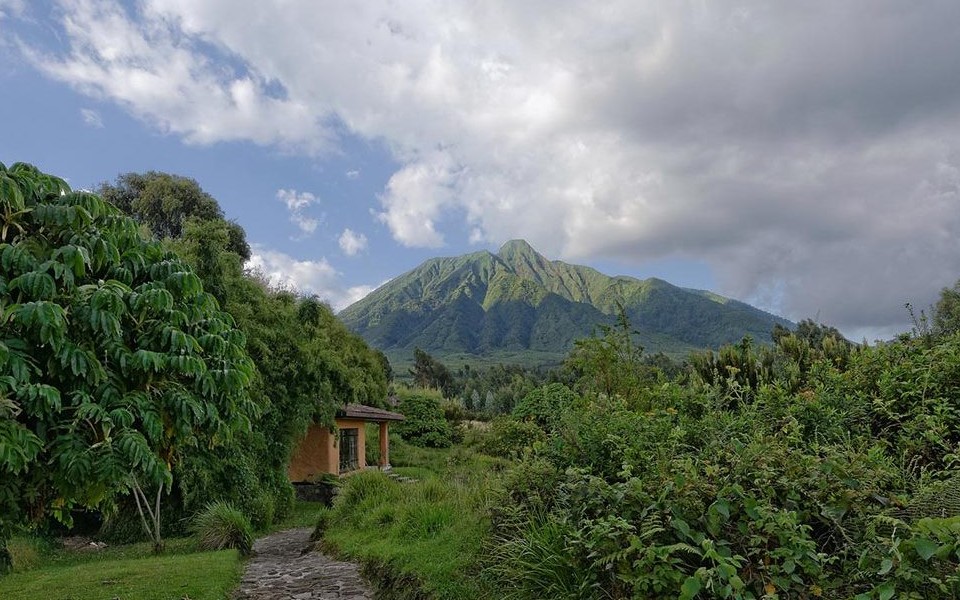Vegetation in Volcanoes National Park
The mountain gorillas being found in Volcanoes National Park makes this park one of the most visited parks for gorilla trekking. These unique Giant Apes are only found in mountainous and forested areas with cool weather conditions.
Interestingly, they are found in only two locations in the whole world (Bwindi National Park and Virunga Mountain Complex) and Volcanoes National Park is one of a kind.

With over 300 of the remaining 880 gorillas in the world, this park offers one of the best destinations for this heartwarming and life changing gorilla trekking experience.
More still, the vegetation types offer a favorable location for their inhabitation and food for their survival. These vegetation zones vary with changing altitudinal ranges within the park and is comprised of Lower montane forest, Neoboutonia forest, Bamboo forest (Arundinaria alpine), Hagenia-Hypericum forest, Lobelia, L.lanurensis and Senecio erici-rosenii, and grasslands.
On the foot/base of the mountain, there is a lower montane forest even though it has mainly been lost to Agriculture. With local communities occupying areas surrounding the park, they continuously encroach its boundaries hence most of this montane forest is being converted into agricultural land (farmland).
When participating in tourism activities for example gorilla trekking or Mount Bisoke hike, you get the opportunity to pass through these pristine farmlands.
From 2400m to 2500m above sea level, there exists a Neoboutonia forest (Neoboutonia macrocalyx).This kind of vegetation can also grow and thrive in areas between 600m and 2700m above sea level.
This type of vegetation has slender and open crowned trees that grow up to 25m though others grow between 10 and 15m, have straight clear bole (trunk) and brittle branches. Are mostly found in forest edges.
The Bamboo forest (Arundinaria alpine) exists in areas between 2500m and 3200m above Sea Level. This Mountain Bamboo has hollow and woody stems that are 2-19m high with diameter ranging from 5-12.5 cm.
They form an important part of the diet of mountain gorillas and the vegetation type covers around 30% of the park region.
This is followed by Hagenia-Hypericum forest found in mostly humid slopes in the South and West of the Park. This type of vegetation is found in areas of 2600 to 3600m above sea level and covers about 30% of the park area.
The Hagenia-Hypericum forest is one of the largest forests of Hagenia abyssinica (Also known as African redwood or East African rosewood).The trees are usually tall up to 25m and with twisted trunks, have pinnate leaves divided like feathers with 11-16 of them being hairy and have toothed leaflets. Their trees have umbrella shaped crowns with attractive leaves.
Area of 3500-4200m above sea level is typified by Lobelia wollastonii also known as Giant Lobelia (has woody stems, about 2-7m tall during flowering, has thick inflorescence and their leaves are hairy in large rosette).
Also characterized by Lobelia lanurensis and Senecio erici-rosenii (is one of the East African giant groundsel and they grow to about 6 meters tall, with time the old leaves fall off leaving a very slender stem, their flower heads have eminent yellow ray flowers.).Areas with the described vegetation type cover about 25% of the park area.
4300m to 4500m is characterized by grasslands (mostly montane grasslands). This is the considerable habitat type on areas of high elevation.
They grow in the wet poorly drained soils. This is followed by secondary thicket, meadows (mostly grass and non woody plants), swamps, marshlands and also small lakes but the total area of these is comparatively smaller.
In conclusion, besides the prominent mountain gorillas that Volcanoes National Park is known for there are various vegetation types that exist in varying altitudes to be uncovered because they are one of the reasons these giant apes inhabit this area and offer a favorable habitat for them. Unique and attractive plant species in the various vegetation zones add to the scenic views of the park.
